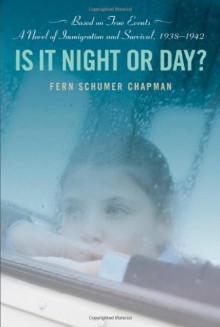
1938. Twelve-year old Edith has lived a protected life in the tiny German town of Stockstadt am Rhein. Now, as brutal acts of anti-Semitism explode in Hitler's Germany, she is about to travel thousands of miles over land and sea to a place that seems as foreign as the moon: Chicago, Illinois. And because her parents can't get permission to leave Germany, she is traveling alone. Haunted by losses, Edith must adjust to life in a country where everyone she meets tries to define her with a single phrase -- German, Jew, enemy alien. And as she struggles to uncover who she really is, the answers arrive from some surprising places. Inspired by the experiences of Fern Schumer Chapman's own mother, one of the 1200 children rescued from the Holocaust by Americans as part of the One Thousand Children project, this dramatic first person story asks the chilling question that all immigrant children who flee alone must answer: What is left when everything is taken away?
~ Hardcover ed. synopsis
POTENTIAL TRIGGER WARNING: This novel does touch upon the topic of suicide.
Teenage Edith's family has lived in the small town of Stockstadt, Germany (just outside of Frankfurt) for two centuries. Even much of Edith's childhood consisted of a very safe, sheltered existence. But now, in the 1930s, the political climate has changed. Suddenly, the most general outings such as grocery shopping, attending movies, even using the community pool, are all carried out with intense fear. Once closeted anti-Semitic neighbors begin to cut ties with Edith's family. {Similar behavior was being carried out all over the world, actually -- South America, Cuba, Shanghai, Hong Kong, Palestine, just to name a few.}
This rising anti-Semitism brings Edith's family the decision to relocate to the United States. During this period in history, there was a program called Kindertransport that sent Jewish children to England for protection, but so many were seeking help that it quickly became near impossible to get into this program, so the States seemed like the next best option. Edith's parents arrange for her to be taken in with relatives in Chicago, Illinois but then soon find out they themselves are unable to leave Germany, so she's forced to make the trip alone.
Is It Night Or Day? is told from Edith's first person perspective. The reader travels with her as she moves through the immigrant lines at Ellis Island, the whirlwind sensory experience she has seeing Times Square for the first time, taking in Rockefeller Center, Radio City Music Hall, the Empire State Building ---- the works! She finds herself immediately fascinated with all the freedoms of America, particularly within the Jewish neighborhood she's moved into: women are wearing nail polish (deemed sinful under Hitler's reign) and both men and women walk about freely displacing Star of David necklaces around their necks.
Edith settles in with her Uncle Jakob and Aunt Mildred. There's immediate tension in the house though, as Mildred seems disgusted with anything German-related (umm, has she met her husband?!) Mildred ends up treating Edith more like a house servant than her niece. In fact, not long after Edith moves in, Mildred hands her a long list of areas of the house she expects Edith to clean every day; she's not given a room of her own but forced to sleep on the living room couch; allowed NO extra snacks between meals; virtually no socializing is allowed in the home AND Mildred is pretty emotionally abusive to Edith to boot. Uncle Jakob (Mildred insists he be called "Uncle Jack") works long hours as an accountant so he's largely unaware of the hard time his niece is having trying to co-exist with his wife.
This being her first experience in her new life in a foreign land, Edith is naturally depressed, but she tries to make the best of her experiences outside the home. Even there, though, life is a constant challenge. She takes in Snow White at the theater, but finds the experience terrifying. She attends her first school dance, develops a crush on a boy, but then feels guilty for feeling joy about something when she thinks of how much her parents back in Germany must be struggling.
I couldn't enjoy anything. Just like when I had come over on the boat years ago, I wasn't hungry and, when I did eat, nothing had any taste -- even ice cream. Sorrow was always with me. And when I experienced things that had brought me pleasure in the past -- a warm day, a walk, a meal with braided bread, anything that I might have shared with my parents -- I was overwhelmed with grief.
Her experiences in the American school system prove to be some of her biggest challenges in this new life. Because her English is limited, teenage Edith is placed in a class of first graders and from day one forced to say The Pledge of Allegiance. What I thought was odd was the description of how the pledge was done. Never in all my school years, did we ever recite the pledge with our arms straight out?! But the moment proves triggering for Edith, as it looks too close to the Nazi salute:
The children stood facing the flag and lifted their right arms straight out in front of their bodies, palms down, while saying the pledge. Watching them, I gasped, remembering when students in my German classroom started using the Nazi salute, just about the time the neighbors beat up my father.
But she soon discovers she has a knack for learning language, so she finds herself grasping English very quickly, moving through the grades until she is with her peer grade in just a matter of months. But here again comes the guilt: Does success in her American studies mean she is betraying or disrespecting her German roots?
Edith struggles to find a balance in her heart, a struggle that seems amplified whenever she tries to set up meetings with her sister, Betty. Betty had come to the States some time before Edith and was placed with a foster family about an hour away from where Edith is living now. Though it might not seem such a distance, it takes about a month after Edith's arrival in the country for the sisters to find opportunity to meet up. Though happy for the reunion, Edith is taken aback at just how much Betty seems to have embraced her life in America. Much like Mildred, Betty prefers to distance herself from anything German now, even advising Edith to stop speaking in German altogether as soon as possible. Once again, that torn feeling. She sees the benefits of "toning down" her German-ness here, but she also wants to honor her parents who have sacrificed so much to provide her with a safer life situation.
This novel also provides a bit of a side story on the historical fiction front. At one point, Edith receives a letter from a boy she met and befriended on the boat to America. He writes that he was placed in an orphanage in Alabama, and from his town has witnessed first hand the result of Jim Crow laws, likening the signs he sees to the "No Jews" signs they'd both seen posted elsewhere. The education on racism continues when Edith first discovers a love for the game of baseball. When invited to attend her first stadium game to see the White Sox, she is so taken with the excitement of the environment! That is, until she hears men in the seats in front of her hurling racial slurs at Jewish Detroit Tigers power-hitter Hank Greenberg.
Instead of trying to make friends, I started going to the library; it was the only place where I wasn't the poor refugee girl or the Kraut or, even worse, the Jew. I could just be me and lose myself in books. And there, I got the first thing that could belong only to me: a library card.... What was really important though, was that I felt safe there. The characters in my books didn't tease me, hurt me, reject or abandon me. They were much more reliable than real people, and not even Aunt Mildred could take them away.
Inspired by the true story of her own mother, author / journalist Fern Schumer Chapman writes one moving tale of one of the lesser known aspects of this heartbreaking era in history. Chapman writes in her afterword that her mother (also named Edith) was one of the children taken into the One Thousand Children Project. While relaying a dramatic but continually interesting story regarding an important historical snapshot, Chapman's writing style itself has a natural, comfortable flow to it that sets the reader up for a touching, empathy-inducing reading experience all around. I highly recommend educators try this one as a teaching tool for easing middle-grade history students into such a heart-wrenching history lesson.

 Log in with Facebook
Log in with Facebook 








